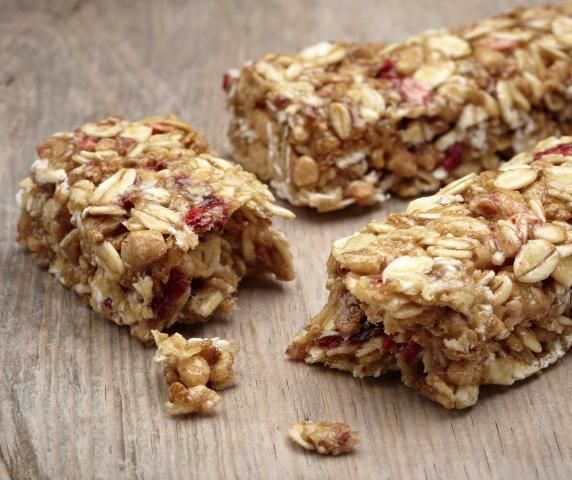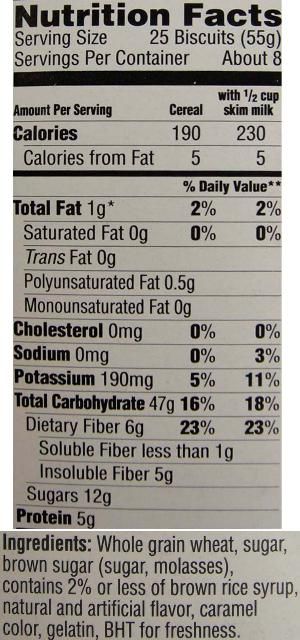Shopping for Health: Foods with Added Fiber
Fiber in foods consists of carbohydrates that cannot be digested. Although many foods naturally contain fiber, high-fiber ingredients are commonly added to foods to increase their fiber content. Fiber ingredients may be added to foods for health or functional reasons.
Fibers, such as carrageenan, guar gum, xanthan gum, and pectin are added to foods to thicken or stabilize them. For example, carrageenan, which is found in chocolate milk, and xanthan gum, which is found in salad dressings, are both added to prevent ingredients from settling at the bottom of the container. Pectin is added to jams and jellies to thicken them. In addition, some fiber ingredients, when dispersed in water, have a fat-like texture that can be used to replace a portion of fat in some foods. Adding fiber to foods also increases water absorption, preserves moisture, affects crumb texture and tenderness, and modifies color and flavor. As only very small amounts of these fibers are used in most foods, they contribute little to total fiber intake.

Credit: iStock
In terms of nutrition, increasing the total fiber content of foods is the most important reason for adding fiber to foods. Although fiber is naturally present in fruits, vegetables, whole grains, beans, nuts, and seeds, most people do not consume enough of these foods. Thus, they consume far less fiber than recommended (McGill, Birkitt, and Fulgonii III 2016). To help people reach their recommended fiber intake, fiber ingredients are currently being added to breakfast cereals, breads, snack bars, yogurts, and beverages.
Many different fiber ingredients are added to foods to increase their fiber content. Some examples of added fiber ingredients are wheat bran, soy fiber, cellulose, corn bran, and pea hull fiber. These fibers have been isolated from various grain, legume, or vegetable crops. For example, fibers such as corn bran or pea hull are made by removing and grinding the bran or hull from the cereal or legume seed. Further processing, such as washing and bleaching, can improve the taste and lessen the color of the fiber ingredient.
Can Foods with Added Fiber Help Increase Fiber Intake?
In terms of nutrition, increasing the total fiber content of foods is the most important reason for adding fiber to foods. Although fiber is naturally present in fruits, vegetables, whole grains, beans, nuts, and seeds, most people do not consume enough of these foods. Thus, they consume far less fiber than recommended (McGill, Birkitt, and Fulgonii III 2016). In attempts to help people reach their recommended fiber intake, fiber ingredients are currently being added to breakfast cereals, breads, snack bars, yogurts, and beverages.
Many different fiber ingredients are added to foods to increase their fiber content. Some examples of added fiber ingredients are wheat bran, soy fiber, cellulose, corn bran, and pea hull fiber. These fibers have been isolated from various grain, legume, or vegetable crops. For example, fibers such as corn bran or pea hull are made by removing and grinding the bran or hull from the cereal or legume seed. Further processing, such as washing and bleaching, can improve the taste and lessen the color of the fiber ingredient.
How much fiber is added to foods?
The amount of fiber added to foods varies. When at least 2.5 g of fiber has been added to a serving of food (compared to the original food), it can be labelled as having “more or added fiber (FDA 2020).” A “good source of fiber” contains 2.5 g to 4.9 g of fiber per serving, and a “high fiber” food contains 5 g of fiber or more per serving (FDA 2020). The total fiber content listed on the label (in g) includes both naturally occurring dietary fiber and also added fiber shown to have a health benefit.

Credit: Wendy Dahl, UF/IFAS

Credit: Wendy Dahl, UF/IFAS
What are the health effects of added fiber?
Although recommendations state that healthy women should consume about 25 g of fiber per day and men consume 38 g of fiber per day (Institute of Medicine 2005), most people do not consume enough. For maximum health benefits, choose foods that naturally contain dietary fiber, such as fruits, vegetables, beans, whole grains, nuts, and seeds. However, foods with added fiber ingredients may be considered healthy choices as well.
Added fiber ingredients differ in their physical properties and health effects. Commonly used categories include soluble and insoluble fibers. Soluble fibers dissolve in water and are easily added to foods, often without unwanted changes in taste and texture. These fibers are often added to beverages and foods high in water, such as yogurt. Examples of soluble fiber ingredients are chicory root fiber (also called inulin or oligofructose), corn and wheat dextrins, hydrolyzed guar gum, and soy fiber. Soluble fibers, like all fibers, are not digested, and are generally broken down (fermented) by bacteria in the colon. Some soluble fibers, such as inulin, promote the growth of Bifidobacteria, which are thought to enhance health (Shoaib et. al 2016). The products of fiber fermentation help keep our colons healthy and provide us with energy.
Some soluble fiber ingredients enhance viscosity (thicken). Viscous fibers help to decrease blood glucose and cholesterol levels (Chutkan, Fahey, Wright, and McRorie 2012). Oatmeal and okra are two examples of foods that naturally contain viscous fibers. Since these fibers change a food’s texture, viscous fibers are rarely added to food to increase fiber content. A cookie with added viscous fiber, for example, may become “gummy” or “sticky” when chewed. An example of a viscous fiber ingredient that is added to a few foods is psyllium fiber.
Many fiber ingredients are insoluble (do not dissolve in water), making them a rare addition to beverages and foods high in water content. Insoluble fibers are the best choices for bulking stools and preventing constipation. Insoluble fibers work well as ingredients in baked goods, such as bread, cookies, and muffins. Many of these fibers are easily substituted for some of the flour in recipes, which may create a similar but healthier product because of its higher fiber and lower calorie content. Examples of insoluble fibers that are added to foods include cellulose, pea hull fiber, wheat bran, and corn bran.
When choosing foods with added fiber, consider what health outcomes you want. If prevention of constipation is needed, choose foods with added cellulose, hull, or bran fibers. If you need to reduce your blood glucose and cholesterol levels, choose foods with an added viscous fiber, such as psyllium fiber. Choosing a variety of fiber sources, soluble and insoluble, may be best for gastrointestinal and general wellness.
References
Chutkan, R., Fahey, G., Wright, W.L., and McRorie, J. 2012. "Viscous versus nonviscous soluble fiber supplements: mechanisms and evidence for fiber-specific health benefits." Journal of the American Academy of Nurse Practitioners (JAANP) 24:476–87.
McGill, C. R., A. Birkett, and V. L. Fulgonii Iii. 2016. "Healthy Eating Index-2010 and food groups consumed by US adults who meet or exceed fiber intake recommendations NHANES 2001–2010." Food Nutr Res 60:29977. doi: 10.3402/fnr.v60.29977.
Institute of Medicine, Food and Nutrition Board. 2005. Dietary Reference Intakes for energy, carbohydrate, fiber, fat, fatty acids, cholesterol, protein, and amino acids. Pp. 339–421., Washington, DC. The National Academies Press, 2005.
Shoaib, M., A. Shehzad, M. Omar, A. Rakha, H. Raza, H. R. Sharif, A. Shakeel, A. Ansari, and S. Niazi. 2016. "Inulin: Properties, health benefits and food applications." Carbohydr Polym 147:444–54. doi: 10.1016/j.carbpol.2016.04.020.
U.S. Department of Agriculture, Agricultural Research Service, Beltsville Human Nutrition Research Center, Food Surveys Research Group and U.S. Department of Health and Human Services, Centers for Disease Control and Prevention, National Center for Health Statistics. "What We Eat in America, NHANES, 2003–2006".
U.S. Food and Drug Administration. 2020. " Code of Federal Regulations Title 21Food and Drugs: Subchapter B. Food for Human Consumption, 2020". Retrieved from https://www.accessdata.fda.gov/scripts/cdrh/cfdocs/cfCFR/CFRSearch.cfm?fr=101.17&SearchTerm=fiber.



